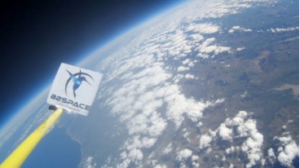From a crazy idea to space and beyond! How imagination led a group of friends to design a system to launch rockets and satellites to space using stratospheric balloons.
In October 2012, Felix Baumgartner jumped in his spacesuit from the edge of space. He had climbed in a specifically designed pod, lifted by a huge stratospheric balloon (bigger than the Big Ben) to 123,491 ft (38,969 metres) breaking several world records:
- Breaching the sound barrier in his descent, reaching 377 metres per second (843 mph)
- Highest altitude in a manned balloon
- Highest altitude jump, breaking a record from 1960 by Colonel Kittinger
This jump has inspired many people, young and old, and has pushed companies to unleash the potential that the stratosphere has to offer, and how a relatively simple technology such as balloons can get us a step closer to the stars.
The stratosphere layer of the atmosphere is a harsh environment, with temperatures dropping to -60 degrees Celsius – a pressure so low that makes human flight only possible with suitable suits or pressurised cabins.
The stratosphere layer of the atmosphere just above the troposphere, and extends from an altitude of 11km to approximately 50 km. It is a harsh environment, with temperatures dropping to -60 degrees Celsius, an atmospheric pressure dramatically low that makes human flight only possible with suitable suits or pressurised cabins, and additionally, there are high radiation levels due to cosmic rays and solar radiation. In some ways, it is like a Martian atmosphere and a good place to test how life could survive in such conditions.
However, this hostile environment can be an advantage when you want to launch rockets to space. All rockets must use their power to gain the kinetic and potential energy required to get to a certain orbit (Orbital Velocity and Altitude). They need to “fight” against gravity and forces of aerodynamic drag.
Vertical Launchers (rocket vehicles launched from the ground) such as Space X Falcon 9, Arianne 5, or the Soyuz’s, must face huge aerodynamic drag as they climb through the atmosphere, having to break the sound barrier and withstand tremendous aerodynamic loads. In the first 20 miles of ascent, these rockets burn more than 60% of all the propellant they carry.
But what if we could avoid this? Is there any way to launch more efficiently to orbit? This goal is what the team of B2Space, a young company based in Newport, UK, aimed to achieve. A more efficient, flexible, and low-cost way of launching satellites into orbit.
Our goal is to find a more efficient, flexible, and low-cost way of launching satellites into orbit.
Inspired by the video of the jump from Felix Baumgartner, we asked the question: what if we place a rocket beneath a stratospheric balloon and launch it from 35 km of altitude? Would it make a big difference?
We started to do some research and found out that this was a concept called “Rockoon” (Rocket + Balloon) proposed first in 1949 by Cmdr. Lee Lewis, Cmdr. G. Halvorson, S. F. Singer, and James A. Van Allen. They were used mainly for atmospheric research, but with now intention to develop them to launch satellites into space.
Analysing the facts, launching from the stratosphere at 35 km of altitude has huge advantages. At such altitude, the atmosphere is more than a thousand times thinner than on the ground. This reduces the loss of energy due to atmospheric drag more than 99%, and therefore it also reduces the aerodynamic loads considerably. In a practical application, B2Space team found that to launch 200 kg satellite into space from 35 km of altitude it is required 70% less propellant than an equivalent rocket launching from the ground. Having to carry 70% less propellant means less weight and that you don’t need such a big tank, therefore the launch vehicle will be much smaller, and the structures can be further optimised, adding into the weight saving.
Another advantage is that rocket engines tend to have better performance when working in vacuum. This is because the thrust of a rocket engine is proportional to the difference between the combustion chamber pressure and the ambient pressure. The ambient pressure is negligible at 35 km of altitude compared with ground pressure; therefore, the performance of the engines will be higher at altitude. These advantages, among others, convinced our team at B2Space to go for it, try to make it happen.
And to our surprise, we discovered that we didn’t need to be millionaires to start a space business, we could start with simple, cheap, and efficient ways to test our concepts and technology to try to achieve our dreams (as for the rockoon concept there are not only advantages but as well enormous technical challenges to overcome).
First, we needed to understand better how the stratosphere works, how our electronics would behave in such a harsh environment. We decided to buy weather balloons, design a small on-board computer with sensors and cameras and fly to the edge of Space.


Images from our first ever balloon flight. Credit: Valentin Canales, B2Space
The flight helped us understand how electronics behave with low temperatures, in nearly vacuum conditions and receiving high doses of radiation: this was the first step to solve on the main technical challenges of a rockoon system, which is operating in this such harsh environment and ensuring the reliability of all systems.
Once we solved the first challenge, we focused on the second: controlling and predicting the balloon trajectories. Balloons drift with the air, and at each layer of the atmosphere it moves at the same speed and direction as the wind. It is quite difficult to predict the weather, and the closer you are to the ground the more difficult it gets. But the higher layers of the atmosphere are more stable and predictable. Also, we have an ally: weather satellites. Using real time information from weather satellites worldwide, we can obtain accurate information on wind speeds and directions at the different layers of the atmosphere. Using this information, we can predict where the balloon will travel, ensuring we only release it from locations from where it is safe and from where it will travel to the right locations. To test this model, we started to use larger and larger balloons to verify its accuracy:
After we solved the second challenge, we were able to convince investors and obtain R&D grants from ESA, UK Space Agency, Welsh Government and STFC to help us achieve our ambitions and grow our team, with 12 employees in our team now.
The third challenge is to launch the rockets from the balloon in a safe and controlled manner. As one can imagine, a rocket cannot just hang below a balloon and be ignited as it is: it could point anywhere and be very dangerous for life and property on the ground and sea.
So, our team needed to find a way to make this possible in a safe and reliable way. The solution we found is an automated platform that understands its position, points the rocket into the right direction and then stabilizes it during the ignition and launch. Using a series of mechanisms, motors, and devices we were able to achieve this goal, and we have completed the design of this key element.
Today, we are manufacturing and testing this platform, with our views on a key date: In summer 2021, our team will launch a 50 kg rocket from a stratospheric balloon and will achieve more than 120 km of altitude in a parabolic flight. It will be the first time ever that a rocket launched from the UK will reach space, marking an historical milestone in the UK aerospace history. After this, our team will scale up the rocket, the platform, and the balloon, with the intention of being the first private company in the UK to launch satellites to space, and the first ever company in history to do it from balloons.
And all this started with a video and weather balloons…
But there are plenty more things that can be achieved with simple technology such as stratospheric balloons. As explained earlier on, the stratosphere has extreme conditions that can be defined as “Near Space” environment, therefore is suitable to test technologies that later will be sent inside satellites or for spacecrafts built to carry humans. This is what B2Space is doing: offering customers to use its balloons and platform to test technologies and perform experiments in Near Space conditions, so that they can speed up their development cycles and get their technology to space earlier.
But that’s not all.
What if you add sensors, cameras, and instruments to a high-altitude balloon?
You are creating a HAPS: High Altitude Platform Systems or High-Altitude Pseudo Satellites. This can be very useful, because as ESA highlights, HAPS can be the missing link between drones and satellites, mixing benefits from both: covering large areas as satellites but providing real time information such as drones, as satellites only pass the same point of Earth several times per day at max, not allowing for continuous monitoring. This can be helpful in fire prevention and fighting, helping to control illegal fishing, early detection of oil spills… applications can be countless.
What application would you use a satellite or HAPS for?
As you see, you don’t need much to start doing space science and technology, so if you have an idea, go for it, work and test it!
Download PDF
If you wish to save, or print, this article please use this pdf version »


